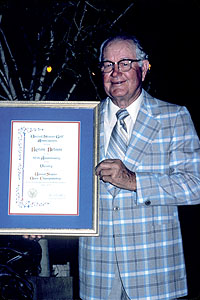
- received an honor 40 years after he won The Open
Story courtesy USGA
DALLAS, Texas (Sept. 26, 2006) -- The 1939 U.S. Open champion, Byron Nelson, who in 1945 had arguably the greatest season in professional golf history, died on Sept. 26 in his Dallas, Texas, home at the age of 94.
Universally loved for his gracious and gregarious demeanor, Nelson was the last survivor of professional golf's early days, a list that included the likes of Gene Sarazen, Ben Hogan and Sam Snead. Many golf historians considered Nelson to possess the first "modern" swing that served as the model for the USGA's mechanical golfer (Iron Byron) to test golf balls.
Twice, Nelson was the PGA Tour's leading money winner (1944 and '45) and he was named to two U.S. Ryder Cup teams as well as captain of the 1965 squad. In 1974, Nelson was inducted into the Golf Hall of Fame, the same year the USGA bestowed him with its highest honor, the Bob Jones Award, given annually in recognition of an individual's distinguished sportsmanship in golf.
But it's the 1945 season that will be forever linked to Nelson's legacy. No player has even come close to the 11 consecutive victories or the 18 single-season titles. In 30 events that season, his stroke average was 68.33 and he was a cumulative 320 under par. Nelson earned the equivalent of $63,335 in War Bonds, a staggering 14.5 percent of the total prize money on offer. Translated into today's dollars, it would likely equate to somewhere around $10 or 11 million.
Nelson played during an era without huge purses or major endorsements. In 1945, he played in 30 events out of financial necessity. "[Today's players] don't have to play 30 tournaments a year," Nelson once told The Associated Press. "I did. I had to eat."
While Nelson collected just five majors – two Masters, two PGA Championships and one U.S. Open – World War II likely prevented him from attaining more. The U.S. Open and Masters were not played from 1942-45, but Nelson was exempt from serving in the armed forces because he was a hemophiliac. That freed him up to compete in tournaments and exhibitions, especially in 1945, the last year of the war.
Born Feb. 4, 1912 in Waxahachie, Texas, Nelson grew up in Fort Worth and caddied at the same club as another future Hall of Famer, Ben Hogan. The two squared off for the Glen Garden Country Club caddie championship in 1927, with Nelson winning.
Nelson turned pro in 1932 and five years later, he captured his first major, the 1937 Masters. At the time of his victory, renowned Atlanta-based sportswriter O.B. Keeler gave Nelson the nickname "Lord Byron." Because Keeler was also filing reports for The Associated Press, the mantra appeared in headlines across the country. The nickname stuck and Nelson became an icon in the golf world.
Two years later, Nelson survived a 36-hole playoff with Craig Wood at Philadelphia Country
Club's Spring Hill Course to win the U.S. Open. Nelson made up five strokes in the last round to get into the playoff with Wood and Denny Shute, while Snead, who needed a 5 at the 72nd hole to take the championship, posted an 8 and finished fifth. Wood appeared to have the championship won in the playoff, but Nelson birdied the final hole to force yet another 18-hole playoff (sudden death was not an option at the time). In the second 18, Nelson holed out a 1-iron shot for an eagle-2 at the fourth hole and went on to shoot a 70 and defeat Wood by three strokes.
A year later, Nelson won the first of his two PGA titles with a 1-up victory over Snead in the championship match (the PGA didn't switch to stroke play until 1958). Nelson would lose in the final a year later to Vic Ghezzi, 1 up, but won again during his brilliant 11-straight title run in 1945, defeating Sam Byrd in the final, 4 and 3. In between, Nelson collected a second Masters in 1942.
After his remarkable 1945 campaign, Nelson recorded six victories in 1946, but that would be his last full-time competitive season. Like Jones 17 years earlier, Nelson, then just 34, decided to retire from competitive golf at the peak of his career, purchasing a ranch in his native state of Texas.
Following his playing days, Nelson did some television commentary and received acclaim as a teacher, with two of his notable students being 1964 U.S. Open champion Ken Venturi and 1982 U.S. Open winner Tom Watson. It was Venturi who called Nelson "the inventor of the modern golf swing" and the "purest ball striker he's ever seen."
He also served as the honorary starter at the Masters, along with Snead and Sarazen, until 2001. In the ensuing years, Nelson often could be found seated at the first tee greeting the game's stars as well as tournament officials. The bridge that leads from Augusta National's 13th tee to the fairway is named in his honor.
In 1968, the PGA Tour renamed the Dallas Open, an event Nelson won seven times, the Byron Nelson Classic. Even today, this non-major on the circuit is always well attended by the game's biggest stars, including Tiger Woods, mainly because they wanted to pay tribute to one of the game's greatest gentleman and statesman.
The main attraction is now gone, but he won't ever be forgotten.
David Shefter is a USGA staff writer. E-mail him with questions or comments at dshefter@usga.org.